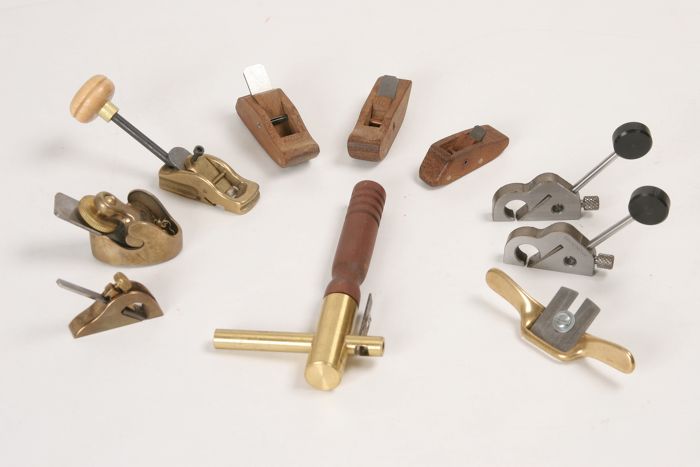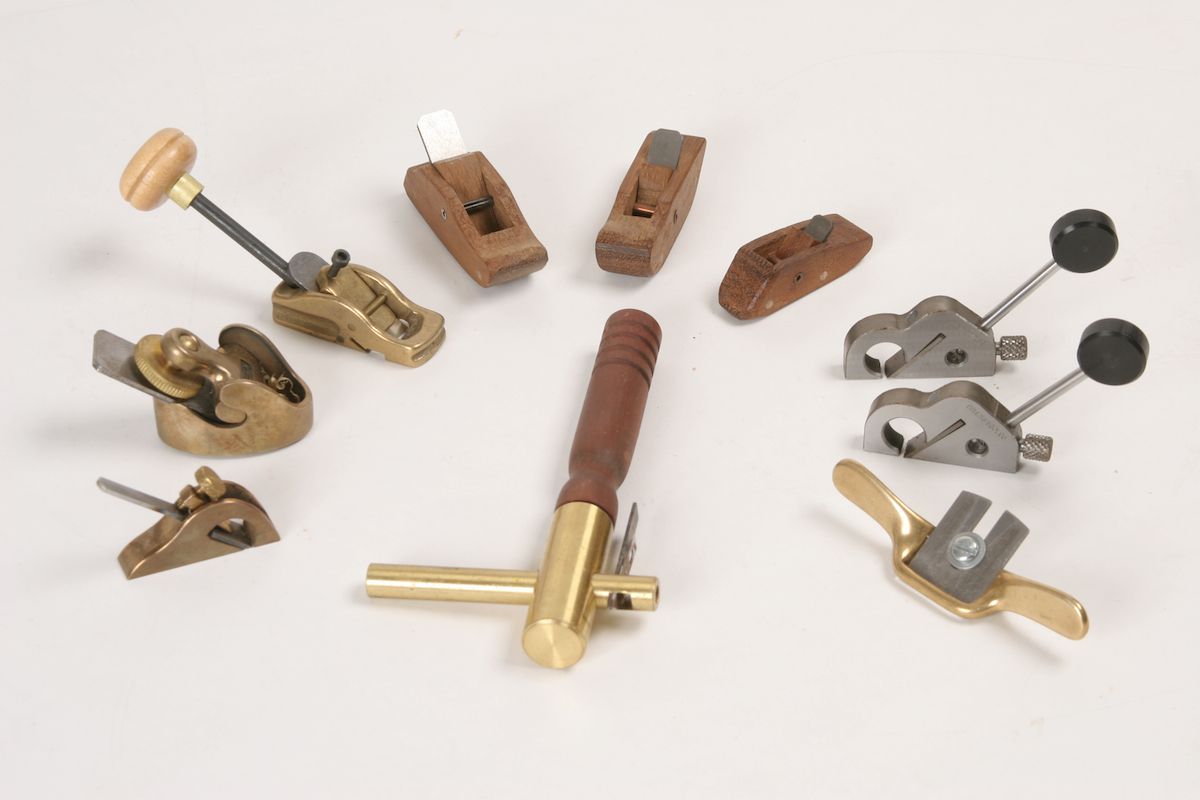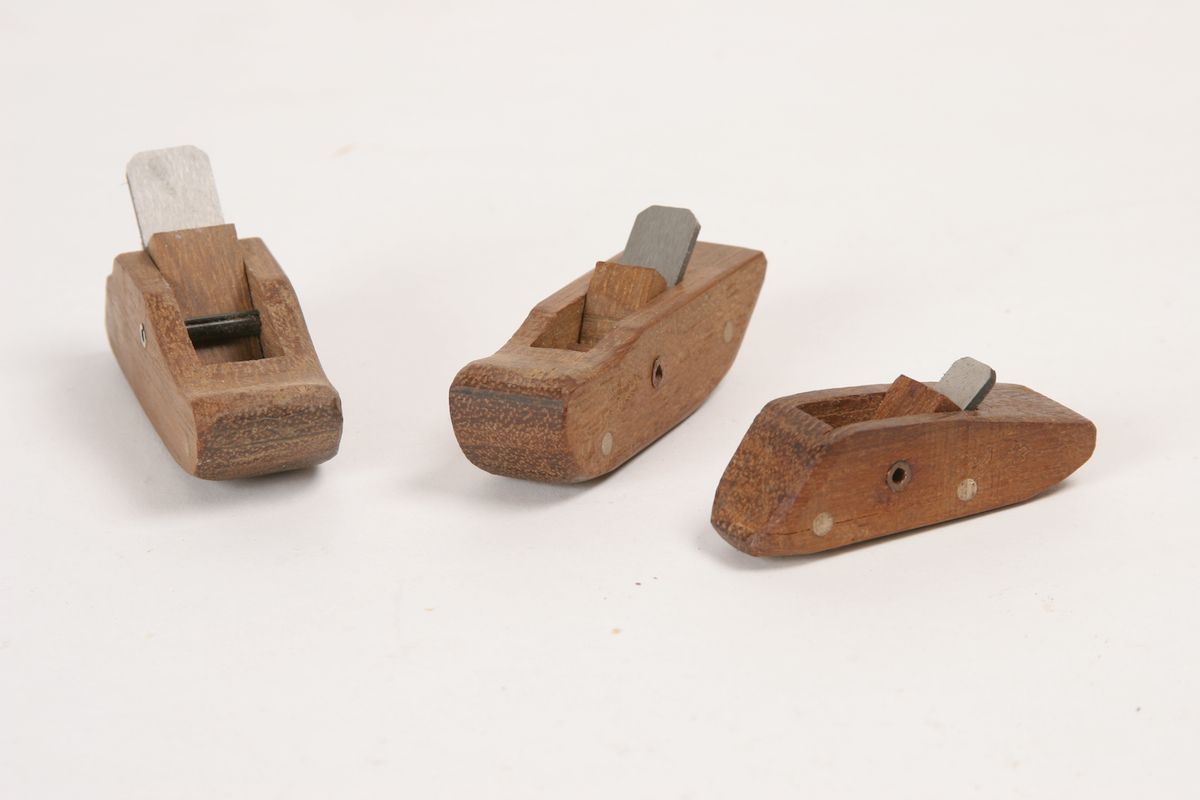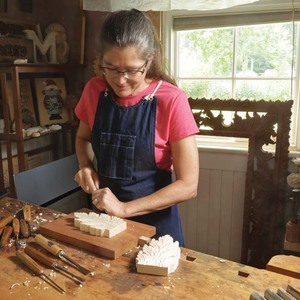
A collection of small tools from Smishkewych's Luthier's Toy Chest. From left: a bronze rabbet plane, a convex-sole violinmaker's plane, a bowmaker's concave-sole plane with palm rest, three wooden planes by the author, a pair of "bunny" planes, and a miniature spokeshave. Center: a purfling cutter.
My experience as an instrument builder translates in new ways to furniture building, which I am avidly engaging as a new editor at Fine Woodworking. The small-scale accuracy of luthiery helps when dealing with precise joint work, such as a recent box made under the tutelage of FW’s own Matt Kenney. (I’ll be blogging on that project next week.)
Luthiers use many familiar hand and power tools: bandsaws, belt sanders, drill presses are all familiar sights in an instrument shop, and some makers–for example, harpsichord builders–will use standard cabinetmaking machines such as table saws, jointers, and planers. We also tend to have an assortment of wacky hand tools that are unique to the trade, aside from the usual saws, planes, and chisels. These include purfling cutters (center of the photograph), peg shavers, tapered reamers that match the slope of violin and lute family pegs, and soundpost setters. And then we have tools that are just tiny version of your usual ones. Enter my favorite form this last category: Baby planes.
For all of you Krenov enthusiasts out there, making your own baby planes out of wood scraps is almost identical to the regular “Krenov plane” technique. You just reduce the dimensions of a regular plane to the necessary size. (For scale, the smallest of the wooden planes—right hand side of the detail photo—is 3 cm, or 1 1/4 in., long. You’ll also notice that these are completely convex bottoms, front-to-back and side-to-side.) One of the main tricks that makes these planes slightly more challenging is fitting the wedge for the blade. Another is adjusting the size of the throat, which at this small scale requires the use of a detail file. Since these planes don’t have a chipbreaker, the blades are turned bevel-down and the slope of the wedge helps lever the chips out, as would be the case with a Japanese plane.
These little planes are normally used to carve out the insides of bellies and backs of violin and other archtop instruments. But in some projects I am designing, I’m envisioning possible uses for these planes in tight spots for which I might not have a tool at the moment. For example, I’m planning to build a small sewing box in japanese tansu style, that’ll include shaped handles along both top edges. In order to make the gentle curve on the inside bottom of those handles, I’ll want to use one of these small planes. They’re great at handling funny grain in tight quarters.
Some of this crossover tool usage goes the other way, of course: the metal-bodied trim planes (sometimes called “bunny planes”) are sometimes used by finish carpenters to adjust trim and moldings; they’re great for small areas in instruments.
I’ll be happy to post more photos and blogs about the unique tools I have in the Luthier’s Toy Chest. I’d love to know if there’s anything in particular that you’d like to see.
























Comments
I've always been intrigued by violins, and since my 6 year old niece has started taking lessons I found myself inclined to build one. I've never built an instrument before, so i am looking for plans, or instructions, any info. I'm familiar with the bunny/luthier planes, and now have an excuse to add them to my shop :) The first one i make will be my own to learn and play, but i hope to make another for my niece as a gift, once older. Any suggestions? Thanks
Something I always wanted to do. I like building in minature and it takes much more skill as every detail is magnified. Joinery is something someone can learn and all the tools are there, and if ther be an arguement..lok at a cabinet..a nailhole can be covered without notice. that same nailhole insomething 6" or less is an eyesore. I tended to be nore on the machingin side and at work as an pipe insulator have Mcgeyverd alot in the field without the toll you REAALY would like, but at 80 ft inthe air and a 20 minute walk form the shop...you figure something out to leave a professional craftsman job. Instrument making..now that is precision..one wrong cut and youve changed the pitch. A challenge I have not been lucky enough to be apprenticed in. thank for the tool pics
Thanks for the comments and compliments. Actually, there are some great ways to get into instrument making: apprenticing is not at all an esoteric thing, and by simply Googling "violin making apprentice" or "violin making course" you can find a wealth of classes in the US and Canada. There are other courses, aimed towards guitarbuilding (by far the most plentiful) and also towards historical instruments (these programs are easier to find in Europe these days).
If you want to get reading on the topic, try some of the following:
GUITARMAKING: Tradition and Technology
A Complete Reference for the Design & Construction of the Steel-String Folk Guitar & the Classical Guitar
by William R. Cumpiano and Jonathan D. Natelson
(http://www.cumpiano.com/Home/Book/textbook.html)
Classical Guitar Construction
Sloane, Irving
(you can still find used copies on internet)
any Violin Making Book by Edward Heron-Allen, Juliet Barker, Bruce Ossman, or Henry A. Strobel.
The Sloane is a great book because it will help you assemble the tools you need without any huge investment in bizarre stuff--but you can have the chance to make or buy a small plane or two like these if you wish!
Good luck!
So cute, you must get lot of fun with them, I like the ibex ones and the ones in metal colour
I want to see how you use the purfling tool I have one that goes on the end of a dremel but I always wanted to see how the hand operated one works?
Congratulation Masterpiece
Log in or create an account to post a comment.
Sign up Log in